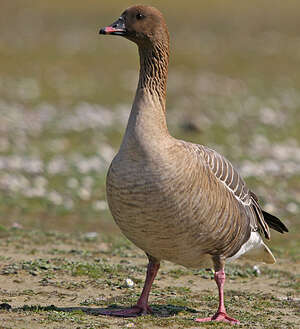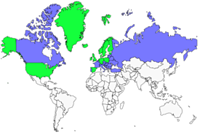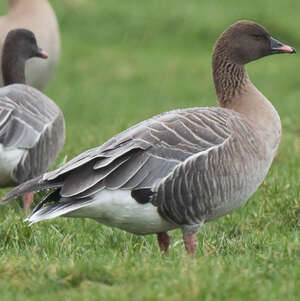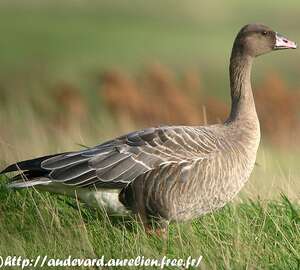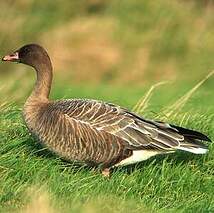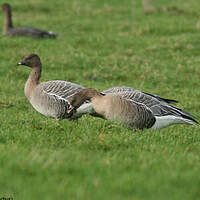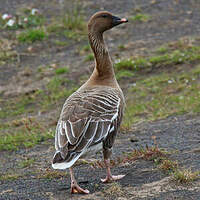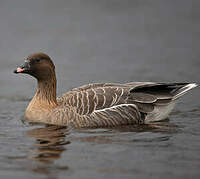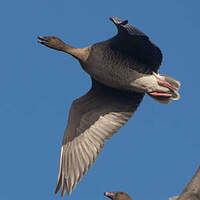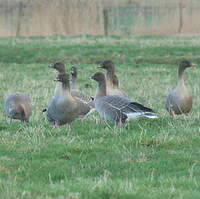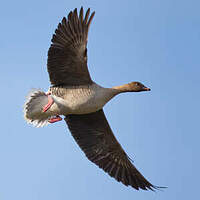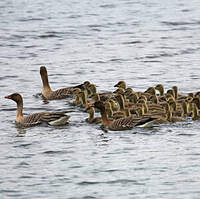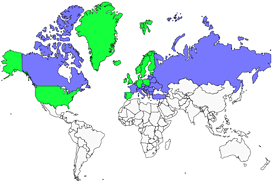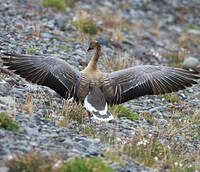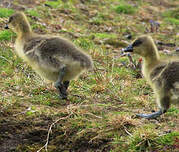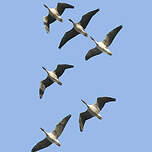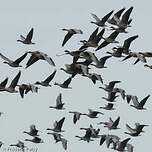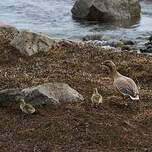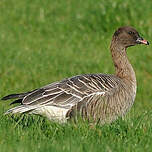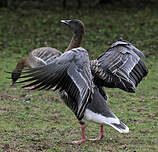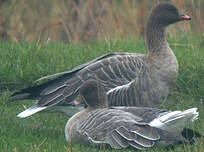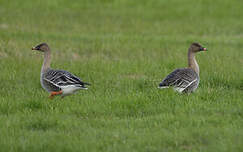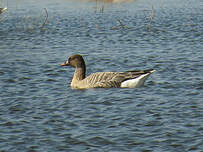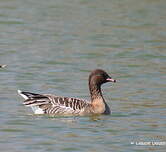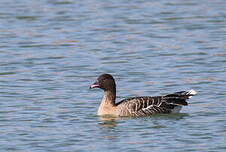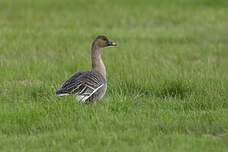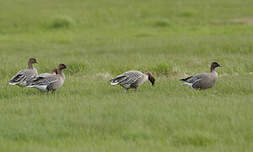Pink-footed Goose
Anser brachyrhynchus - Oie à bec court
Identification
The Pink-footed Goose is a grey goose that looks similar to the Tundra Goose. Like it, it has a rather rounded head that is fairly dark brown and a rather short, high-based beak. Distinguishing between them is relatively easy from a reasonable distance. Look at the colour of the coloured ring around the beak; black in general, but pink on the Pink-footed Goose and orange on the Tundra Goose. Just a head sticking out from a group or outcrop is usually enough for identification. Being able to see its feet is a bonus; pink on the Pink-footed Goose, orange on the other. Identifying them in flight, however, is much more difficult. The plumage is paler and more grey on the Pink-footed Goose, though this can vary depending on the light. Generally speaking, it has the palest overall upperparts, particularly on the scapulars and tertials. Also note the relatively short neck (which is similar to the Greylag Goose), a dark head and neck in contrast (which is similar to the Tundra Goose), a pale grey bow (similar to the Brent Goose) and much more white in the black and white pattern of the tail.
Subspecific information monotypic species
Foreign names
- Oie à bec court,
- Ánsar piquicorto,
- ganso-de-bico-curto,
- Kurzschnabelgans,
- rövidcsőrű lúd,
- Kleine Rietgans,
- Oca zamperosee,
- spetsbergsgås,
- Kortnebbgås,
- hus krátkozobá,
- husa krátkozobá,
- Kortnæbbet Gås,
- lyhytnokkahanhi,
- oca de bec curt,
- Heiðagæs,
- gęś krótkodzioba,
- īsknābja zoss,
- kratkokljuna gos,
- Короткоклювый гуменник,
- コザクラバシガン,
- 粉脚雁,
- 粉腳雁,
Voice song and cries
Habitat
The Pink-footed Goose is a species of the Arctic tundra. Two environmental conditions determine its presence during the summer months.
In winter, it moves closer to the coast and joins other geese in the coastal agricultural lands. It particularly loves lush meadows and cereal fields.
Behaviour character trait
Like all geese, the Pink-footed Goose regains its gregarious instinct after reproduction. Even before, since families with still downy goslings gather and form collective crèches, again for protection.
Much later, when migration time comes, they will leave in groups to go to wintering grounds and will stay together all winter, and likely return together towards their original sites when springtime approaches. Their wintering grounds are around the North Sea.
It is not rare for individuals, usually isolated, to take their independence and find themselves in unusual places for the species. Thus Pink-footed Geese have already been observed multiple times on the Island of Ouessant. Others appear along the French Atlantic coast or even far inland from the coast, like on the big bodies of water of Grand Est. Some may have been pulled along by other geese, such as the Greylag Goose.
Flight
A typical flight of Pink-footed Goose with compact but powerful beats giving enough power for long-range migrations. As with all geese, the long-distance flights are usually organized in a V-formation, with a regular rotation of the lead bird. This way of traveling allows for an energy-saving, with each bird on a line benefitting from the air-flow created by the one before it.
Dietfeeding habits
Like other greylag geese, the Pink-footed Goose is an exclusive vegetarian. During its stay in the tundra, it feeds on elements taken from terrestrial and aquatic herbaceous plants, as well as bushes, leaves, buds, young shoots, rhizomes, fruiting bodies, seeds and berries.
It knows how to dig up the rhizomes of the Polygonaceae, such as bistorta. The consumption of berries such as those of the Ericaceae Empetrum nigrum will provide it with energy before migrating.In winter, it fully enjoys agricultural land. It frequents meadow parks as well as fields of cereals. It has a weakness for potato tubers left on the field.
Geese have a bad reputation for nibbling cereal shoots, but this may not be justified. Indeed, some biologists think that this selective mowing actually contributes to increasing the productivity of winter cereals.
Reproduction nesting
Geographic range
Threats - protection
Sources of information
- IOC World Bird List (v13.2), Gill, F and D Donsker (Eds). 2023.
- Bird Identification, Harris A., Tucker L. and Vinicombe K.
- Guide des canards, des oies et des cygnes, Steve Madge
- Wildfowl: An identification guide to the ducks geese and swans of the world, Madge, S and Burn, H
- Birds of the World, The Cornell Lab of Ornithology
- xeno-canto, Sharing bird sounds from around the world,
Other sources of interest
 Specification sheet created on
27/07/2023 by Jean François
Specification sheet created on
27/07/2023 by Jean FrançoisTranslation by AI Oiseaux.net
published: 17-12-2020 - Updated: 17-12-2020
© 1996-2024 Oiseaux.net
- Accipitriformes
- Aegotheliformes
- Anseriformes
- Apodiformes
- Apterygiformes
- Bucerotiformes
- Caprimulgiformes
- Cariamiformes
- Casuariiformes
- Charadriiformes
- Ciconiiformes
- Coliiformes
- Columbiformes
- Coraciiformes
- Cuculiformes
- Eurypygiformes
- Falconiformes
- Galliformes
- Gaviiformes
- Gruiformes
- Leptosomiformes
- Mesitornithiformes
- Musophagiformes
- Nyctibiiformes
- Opisthocomiformes
- Otidiformes
- Passeriformes
- Pelecaniformes
- Phaethontiformes
- Phoenicopteriformes
- Piciformes
- Podargiformes
- Podicipediformes
- Procellariiformes
- Psittaciformes
- Pterocliformes
- Rheiformes
- Sphenisciformes
- Steatornithiformes
- Strigiformes
- Struthioniformes
- Suliformes
- Tinamiformes
- Trogoniformes

